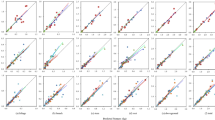Abstract
Using a combination of mathematical modeling and field studies we showed that in dense stands of growing herbaceous plants the vertical pattern of leaf nitrogen distribution resembles the pattern of mean light attenuation in the stand and hence tends to maximize total daily photosynthetic carbon gain of the whole stand. Flowering represents a strong sink of nitrogen away from the photosynthetic apparatus and in herbs like Solidago altissima it induces leaf shedding. We studied both the effect of nitrogen reallocation and leaf shedding on the whole canopy photosynthesis and changes in leaf nitrogen distributions in stands moving from the growing to the flowering stage. Despite a decrease in leaf area index and total nitrogen available for photosynthesis in the flowering stand, the leaf nitrogen distribution here also leads to an almost maximum canopy photosynthesis. In both the growing and the flowering stands the leaf area index was higher than calculated optimum values. It is pointed out that this should not necessarily be interpreted as ‘non-adaptive’.
Similar content being viewed by others
References
Farquhar, G. D. 1989. Models of integrated photosynthesis of cells and leaves. Philosophical Transactions of the Royal Society, London, B, 323: 357–367.
Goudriaan, J. 1988. The oare-bones of leaf angle distribution in radiation models for canopy photosynthesis and energy exchange. Agricultural and Forest Meteorology 43: 155–169.
Harper, J. L. 1989. The value of a leaf. Oecologia 80: 53–58.
Hirose, T. & Werger, M. J. A. 1987a. Maximising daily canopy photosynthesis with respect to the leaf nitrogen allocation pattern in the canopy. Oecologia 72: 520–526.
Hirose, T. & Werger, M. J. A. 1987b. Nitrogen use efficiency in instantaneous and daily photosynthesis of leaves in the canopy of a Solidago altissima stand. Physiologia Plantarum 70: 215–222.
Hirose, T., Werger, M. J. A., Pons, T. L. & van Rheenen, J. W. A. 1988. Canopy structure and leaf nitrogen distribution in a stand of Lysimachia vulgaris L. as influenced by stand density. Oecologia 77: 145–150.
Hirose, T., Werger, M. J. A. & van Rheenen, J. W. A. 1989. Canopy development and leaf nitrogen distribution in a stand of Carex acutiformis. Ecology 70: 1610–1618.
Iwasa, Y. & Cohen, D. 1989. Optimal growth schedule of a perennial plant. American Naturalist 133: 480–505.
Monsi, M. & Saeki, T. 1953. Ueber den Lichtfaktor in den Pflanzengesellschaften und seine Bedeutung für den Stoffproduktion. Japanese Journal of Botany 14: 22–52.
Pons, T. L., Schieving, F., Hirose, T. & Werger, M. J. A. 1989. Optimization of leaf nitrogen allocation for canopy photosynthesis in Lysimachia vulgaris. In: H. Lambers et al. (eds.), Causes and consequences of variation in growth rate and productivity of higher plants, pp. 175–186. SPB Academic Publ., The Hague.
Schieving, F., Pons, T. L., Werger, M. J. A. & Hirose, T. 1992. The vertical distribution of nitrogen and photosynthetic activity at different plant densities in Carex acutiformis. Plant and Soil 14: 9–17.
Sinclair, T. R. & De Wit, C. T. 1975. Photosynthate and nitrogen requirements for seed production by various crops. Science 189: 565–567.
Spitters, C. J. T. 1986. Separating the diffuse and direct component of global radiation and its application for modeling canopy photosynthesis. II. Agricultural and Forest Meteorology 38: 239–250.
Werger, M. J. A. & Hirose, T. 1988. Effects of light climate and nitrogen partitioning on the canopy structure of stands of a dicotyledonous, herbaceous vegetation. In: M. J. A. Werger et al. (eds.), Plant form and vegetation structure, pp. 171–181. SPB Academic Publ., The Hague.
Williams, R. F. 1955. Redistribution of mineral elements during development. Annual Review of Plant Physiology 6: 25–42.
Author information
Authors and Affiliations
Rights and permissions
About this article
Cite this article
Schieving, F., Werger, M.J.A. & Hirose, T. Canopy structure, nitrogen distribution and whole canopy photosynthetic carbon gain in growing and flowering stands of tall herbs. Vegetatio 102, 173–181 (1992). https://doi.org/10.1007/BF00044732
Accepted:
Issue Date:
DOI: https://doi.org/10.1007/BF00044732




